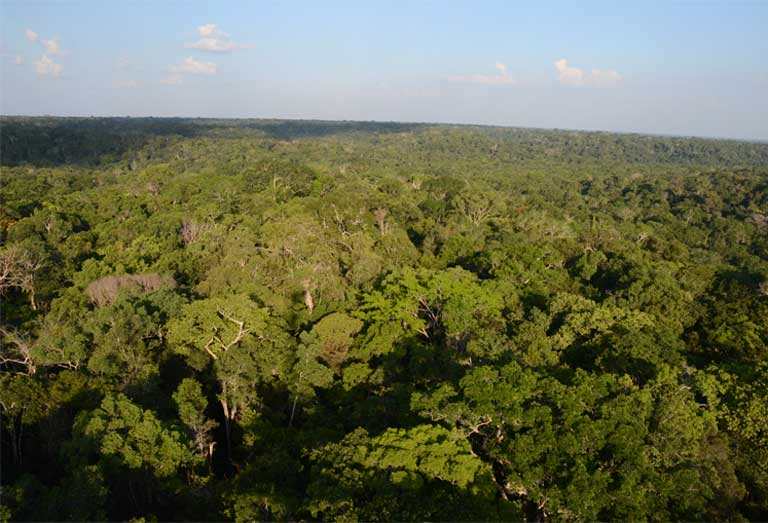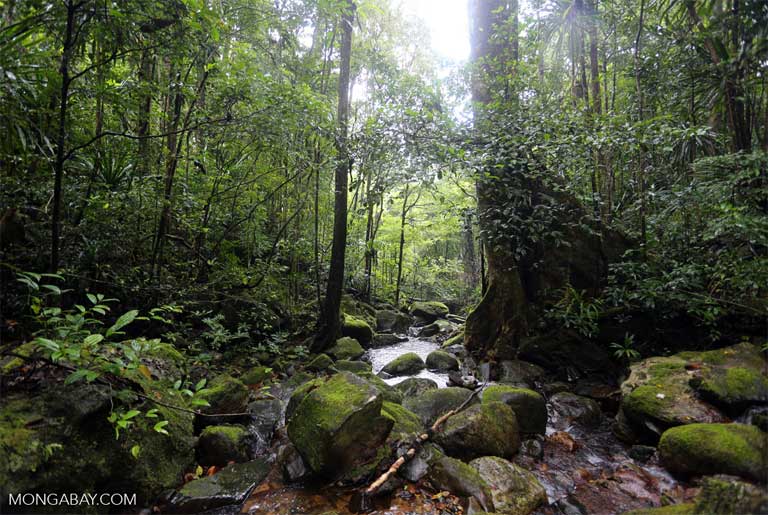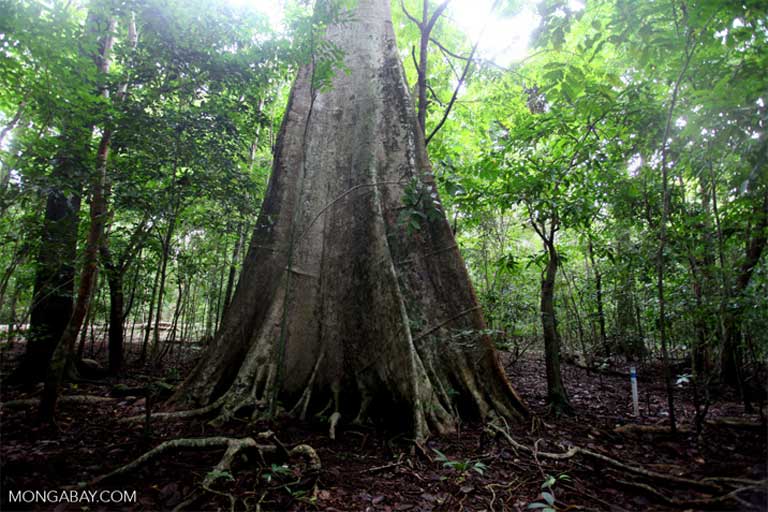- Stomata – the tiny pores through which plants take in carbon dioxide and give off oxygen and water – are closing up everywhere on earth as atmospheric CO2 levels rise. This change in plant structure results in more water being stored within plants, and less being released to the atmosphere.
- In a recent study scientists posit that the reduction in water released by stomata through transpiration will result in changing rainfall patterns across the tropics. Researchers used climate models to test the hypothesis, noting that while reduced transpiration will occur everywhere, tropical climates in different regions respond differently.
- In South America, rainfall patterns are strongly influenced by changes in the amount of water that local plants release to the atmosphere. So if plants there retain more water, deeper droughts could result, consistent with most models. But Africa and Southeast Asia are protected from this atmospheric drying effect.
- Forests in Indonesia, Malaysia and Papua New Guinea are encircled by humid air over warm oceans. Reduced transpiration means more warm air rising from the islands, which draws in moist ocean air, increasing rainfall even as plants release less moisture. Some scientists dispute the study conclusions, noting that climate models poorly simulate water cycling.

Increasing greenhouse gases in the atmosphere could dry out the Amazon and drench Indonesia, all because rising carbon dioxide levels in the air are changing how plants breathe, according to new research published in Nature Climate Change.
James Randerson and Gabriel Kooperman at the University of California, Irvine and colleagues investigated how the physiological response of trees to rising atmospheric greenhouse gas levels affect the output of global climactic models.
The team compared the results of 38 climate simulations based on a fossil-fuel-heavy scenario for the next 100 years, and found a trend of growing asymmetry in rainfall between tropical forests in South America and those in Asia and Africa. This pattern, they say, is driven by regional differences in the role plants play in supplying water to the atmosphere, with South America’s climate more heavily reliant on forests to return water to the air and form clouds, than Indonesia.
According to the scientists, these climactic variations are due to very small changes that occur broadly across all plants as they experience increased atmospheric carbon. As CO2 levels in the atmosphere rise, plants respond by closing their stomata for longer periods. Stomata are the tiny pores on leaf surfaces, stems and bark, that allow plants to absorb carbon dioxide to fuel photosynthesis, while also releasing oxygen and water to the air

More closed stomata result in plant stems retaining more water and releasing less moisture to the atmosphere through transpiration. The reduction in transpiration in response to increasing CO2 levels isn’t new. Tree ring measurements suggest this process has been underway for the past 150 years as global atmospheric CO2 levels have soared from about 280 parts per million (ppm) to more than 410 ppm today.
This single, small change, multiplied across all the plants in tropical forests, could have a huge impact on global rainfall patterns and might explain a quirk in climate model projections.
“Many in the science community were aware that there was a pattern of drying in the Amazon and wetting in Indonesia in the climate model projections,” says Jim Randerson. “What is novel about our study is that we show for the first time that these diverging trends can be traced back to how photosynthesis and tree physiology is represented in the models.”

Tropical climates sensitive to stomata changes
The simulations used in the research, known as Earth System Models, attempt to replicate many known aspects of global climate, factoring in changes to physical processes such as ocean currents and atmospheric winds, as well as alterations in biological effects, including photosynthesis and plant decomposition. The team used simulations that differed in their parameters, but most predicted a pattern of increasing rainfall in Africa and Indonesia, with decreasing rainfall in the Amazon.
“Even though the trees on different continents respond in similar ways to rising CO2, they induce completely different atmospheric circulation responses,” within many of the models, says Randerson.
To find out why, the team ran eight of the simulations a second time, subjecting either the land-based processes or the atmosphere-based processes to increased CO2 levels, but not both. This allowed the scientists to disentangle the relative importance of the factors involved in varying rainfall patterns. Their findings: tropical regions are more strongly affected by plant physiological changes than higher latitudes, which helps explain the major rainfall pattern shifts seen for tropical regions, but not in temperate zones seen within the models.
“I think it’s a really novel finding,” says co-author Abigail Swann, an atmospheric scientist at the University of Washington. “Almost no one is thinking about the fact that the predicted changes in rainfall over tropical land are largely controlled by how plants respond to a changing climate.”

Variable continental climate response
Running the simulations on one continent at a time revealed another key piece of the puzzle: while increased atmospheric CO2 causes reduced transpiration everywhere, geography determines how that effect will play out on a particular continent.
South America’s rainfall patterns, for example, are strongly influenced by changes in the amount of water that plants release into the atmosphere, with 69 percent of the predicted decrease in rainfall there due to a reduction in local recycling of water through plants and evaporation from the soil.
In Africa, the regional climate responds differently to reduced transpiration . Warmer surface temperatures in Africa are linked to a weakening of trade winds that carry moist air from Africa out over the Atlantic Ocean to the forests of South America – a reduction in moisture transport responsible for the remaining 31 percent of rainfall loss over the Amazon.

“I think it’s really interesting that African forests still exert control on the response of Amazon forests to rising CO2,” says Randerson. “Its as if Africa still remembers South America from the time the [two continents] were joined at the hip during the era of Gondwana 350 million years ago.”
Africa and Indonesia are largely protected from the atmospheric drying effect seen in South America: “The tropical forests in Asia, particularly over the islands of Indonesia, Malaysia and Papua New Guinea, are surrounded by humid air above warm ocean waters,” explains Kooperman. Warm air rising from the islands draws in this moist oceanic air, resulting in an overall increase in precipitation. When water evaporates from plants, it also cools the surrounding environment, so reduced transpiration in Asia raises surface temperatures and draws in more oceanic air, paradoxically making this region wetter.

Findings disputed
Douglas Sheil, a tropical forest ecologist at the Norwegian University of Life Sciences who wasn’t involved in the study, agrees that the study addresses an important issue, but isn’t convinced by the researchers’ analysis, “I am skeptical that [this research] tells us much about the future.” Sheil believes the study reveals more about the inner workings of climate models than changes in the real world. “Models aren’t good enough to make these types of predictions,” he argues.
Although the average of all the models used by the team showed a growing asymmetry between a dryer South America and a wetter Indonesia, not all of the simulations agreed, particularly on what the future holds for Africa.
“The [various] models disagree spectacularly on predicted changes, but the authors still want to argue that the rough suggestion of an agreement that is there is meaningful,” Sheil says.
The authors admit to modeling limitations: “When we look at precipitation changes over individual forests in the tropics, many models show different changes,” Kooperman agrees. But he says that in almost all models “while changes at the individual forest level may differ, the relative pattern of change across the tropics as a whole is consistent.”
Sheil, however, points out that climate models are notoriously poor at representing water cycling accurately, and that the particular models used in the study didn’t incorporate recent advances in scientific understanding of the influence on rainfall of changes in tree cover. “Personally… I don’t think [the study conclusion] is convincing,” says Sheil.

To reduce this uncertainly, Randerson agrees that real-world data is needed to validate the model study results. “Large experiments, exposing experimental plots to different CO2 levels, are urgently needed in tropical forests in the Americas, Africa, and Asia,” he says.
If the stomata study’s findings are correct, Randerson and his colleagues suggest that Neotropical forests could be more vulnerable to climate change than currently thought. “They will experience higher temperatures, and will have less available moisture to help with evaporative cooling,” Randerson hypothesizes.
“The Amazon is likely to have an increase in drought and forest fires,” says Kooperman, a trend that is already evident, and which would release much more carbon dioxide into the atmosphere.
More rain in Indonesia, Malaysia and Papua New Guinea could offer some benefits, such as helping replenish dried out peatland habitat. However, more precipitation could also increase flood risk, and intensify soil leaching of minerals vital for plant growth. “Planning for these [complex interrelated] changes and mitigating their effects requires unique strategies tailored to the climate impacts of each region,” says Kooperman.

The time to cut carbon emissions is now
Researchers also agree that ongoing deforestation will likely reduce regional rainfall across the tropics because far fewer trees means far less transpiration. “Maintaining forests by reducing agricultural burning and development in the [tropics] could help to preserve the natural moisture recycling that is necessary for sustaining healthy forests,” even as greenhouse gas emissions and temperatures rise, says Kooperman.
However, the study authors agree with the scientific consensus: they stress that the best way to mitigate the predicted effects of climate change is to reduce greenhouse gas emissions now.
“We need to slow, and then stabilize the build up of carbon dioxide levels in the atmosphere,” says Randerson. He points out that the models used in the new study are based on the RCP 8.5 scenario, the “Representative Concentration Pathway, a simulation which the authors say closely matches our planet’s emissions and global warming trajectory since the scenario was developed in 2005.
“Unfortunately, we seem to be on this path and have shown no prolonged sign of reducing emissions on a global scale,” Kooperman concludes.
“For tropical forests, there are two separate pathways that increase forest vulnerability. One is warming, and the second is the influence of rising CO2 on patterns of precipitation change,” adds Randerson. Without mitigating one or the other, forests across the tropics may see huge changes in annual rainfall over the next 100 years, with dire accompanying impacts ranging from widespread tree death, to crop failure, and a declining water supply for human populations and livestock.
Citation:
Kooperman, G.J., Chen, Y., Hoffman, F.M., Koven, C.D., Lindsay, K., Pritchard, M.S., Swann, A.L.S., and, Randerson, J. T. (2018) Forest response to rising CO2 drives zonally asymmetric rainfall change over tropical land. Nature Climate Change volume 8, pages434–440 (2018) doi:10.1038/s41558-018-0144-7
FEEDBACK: Use this form to send a message to the author of this post. If you want to post a public comment, you can do that at the bottom of the page.

